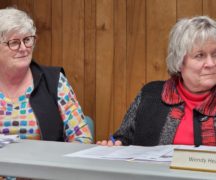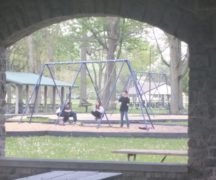By JAN LARSON McLAUGHLIN
BG Independent News
Residents of Wood County have little to worry about from wildlife – at the most a woodchuck burrowing under the house, a pesky squirrel in the attic or rabbits dining in flower beds.
No megafauna remain in Northwest Ohio – except for deer which are usually docile.
“Midwesterners are a little more used to being the ‘big man on campus’ when going outside,” said Craig Spicer, program naturalist with the Wood County Park District. “We rarely see megafauna the size of or bigger than you.”
When Wood Countians travel to areas of the country with big wildlife – bears, cougars and moose – they should be aware of what to do when encountering such animals, Spicer said.
So the park district is offering a series of “self-defense” programs for humans encountering certain wildlife. The first will be Jan. 17 on cougar, followed by one Feb. 14 on moose and deer, and then conclude with one on March 13 on bears. All the programs will be held at 7 p.m., at W.W. Knight Preserve. The series is free, but registration is required at wcparks.org or 419-353-1897.
Each of the programs will begin with basic education on the megafauna, such as their habitats, range and food sources. The participants will learn where contact with such animals is likely, and how to avoid encounters.
“We’ll be cultivating an education and respect for the animal first,” before going into the defense education, Spicer said.
Not wanting to give away all of the tips to be shared during the programs, Spicer hit on some basic safety information.
“Seeing these animals is a big part of the allure of going out there,” he said about more remote areas of western states. “But it’s pretty unwise to put yourself in a dangerous situation.”
For example, anyone in an environment used by cougars must be aware.
Cougars are no longer live in Ohio. “We do not have the habitat here to support them,” he said. But they can be found in many other areas of the U.S.
“Cougars are unique in the fact that in certain situations, though rare, cougars will see humans as prey,” Spicer said.
On the other hand, moose just see humans as a threat.
“They are surprisingly dangerous, even though it’s a herbivore,” he said. “They are huge and see a lot of things as a threat – and they’re big enough to do something about it.”
Deer, the last megafauna remaining in this region, can also cause harm to humans.
“They are still a wild animal, and they can get spooked about anything.”
Though Wood County Park District has not had to take such action, Sidecut Park in Lucas County has had to do deer culling to reduce the numbers. Problems sometimes occur when there are many deer that become comfortable around people.
“They should have some fear of us,” Spicer said.
The last program in the series will look at bear encounters. The participants will learn how to avoid such contact, but if that isn’t successful, they will learn how to defend themselves with “bear attack deterrent,” a heavy duty pepper spray.
Some of the participants will even be able to learn defense techniques on a person in a self-defense suit pretending to be an animal. Spicer, however, will stress the value of avoiding such meetings with megafauna.





